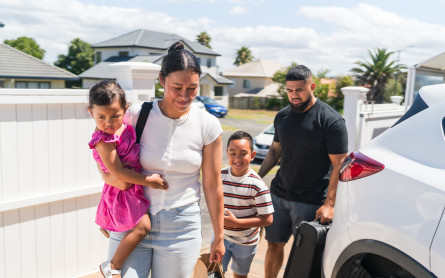
25 July 2025
Reading time: 7 minutes
Told to Philippa Prentice,
0 comments

In the second instalment of our two-part series, real people on everyday budgets shed light on the ways they made their cash cushion happen.
Carla: “My emergency fund is usually funded by any extra income I receive from selling items on Marketplace or having boarders. I wanted to have one so I didn’t get into debt when unexpected expenses came up. I’ve used it for car repairs and a vet bill, and would like to increase it to three to six months of living expenses.”
Angela: “I started by putting away any extra money I earned, so if I worked a public holiday or an extra shift, I’d put that money into a separate account. I then decided to have a goal amount of three months of expenses and would also save a regular amount; it was only small, $20, because I have other things I want to save for too. Now I have that saved, I’m aiming for six months of expenses. I haven’t had to use it yet, partly because I have other savings ‘buckets’ – for car expenses and health expenses, for example. I keep each of these at $1000 and have had to dip into them for new tyres and a root canal, but if I didn't have them, I’d use my emergency fund.”
Briana: “I honestly forget that I have it; it’s in a separate bank account so I can’t see it daily. Every payday, I automatically move $30 into it. It feels like next to nothing, but over the years it’s grown into something I can rely on instead of debt for emergencies.”
Reghan: “When I didn’t have an emergency fund, any issue became an emergency and such a mental burden, so I wanted a safety net to remove that feeling completely. The best advice I could give would be to track your spending and lay it out in the budget planner tool. Find and plug the gaps, and start with a small number you could save and wouldn’t miss. For me, it was $20 a week after I cancelled a couple of subscriptions I wasn’t using. As time passed, I got excited when my savings grew, and I wanted to save more. I was able to start setting financial goals, and once I saved my first $1000, I revised my budget and looked at saving three to six months of expenses.”
Kylie: “What helped me get started is that I started saving for events that were likely to happen, like replacing whiteware, car repairs, etc. Most things people treat as a financial emergency are predictable. By making sure I’m saving towards those items already, I don’t have to touch my emergency fund as often, which has allowed it to grow. I have occasionally had to use it to top up my savings for items that break, but then I’m only topping up what I’ve already saved, rather than using the fund for the full amount.”
Kalala: “I grew mine to $10,000, then had to use it after having a baby, and now I’m starting again. It’s hard, but I love having the calculators to help envision it.”
Britt: “I heard from most financial based accounts I listen to/follow that having an emergency fund should be your number-one priority before any other saving/investing/debt repayments, so I focused on it. I just reallocated money I would have put into regular savings into emergency funds for a few paycheques until I hit my goal.”
Georgia: “I bought a house in 2022 and my emergency fund is there in case I have maintenance I need to undertake on it. It will also be used for any other emergencies I face. It’s in an interest-bearing account, so if I don't withdraw funds during a quarter, I earn bonus interest – always a plus!”
Fiona: “I’ve set up staggered term deposits, one of which matures each month, and have a few thousand sitting in savings accounts so a bit of interest is earned but the money can be used immediately if needed.”
Rebecca: “I have two funds. The first is a ‘mojo’ fund of $10,000 for major emergencies like losing my job and to allow me to have the highest excess settings possible for all insurances. This is offset against a portion of my mortgage. My second is a ‘fire extinguisher’ fund, into which I put $150 a week to fight smaller fires like unexpected bills, car repairs and failed appliances.”
Harry: “We’ve been hit with big bills in the past and been caught short. Since then, we've prioritised split savings – fun, emergency and long term. Each one gets a small top-up each week as per the budget.”
Leonie: “I use ASB’s Save the Change feature, and set and forget it. Always having something needing to be repaired or replaced, or to travel to visit family urgently, means needing ready cash that doesn’t impact my ability to pay bills. Putting a small amount aside and setting it up to happen automatically means I don’t notice it and it just grows quietly in the background. When it reaches a certain amount, I move some of it to a longer-term savings account with higher interest and start letting it build up to that point again, so if I haven’t needed to dip into it for an emergency, it adds to my future savings.”
Georgia: “I have $6000 saved to fund three months of living or if I need to buy a new car. I haven't had to use it yet, but it’s comforting knowing it’s there. To build it, I used a saving account that has 5% interest per month if at least $20 is deposited and no money is withdrawn. This discourages me from withdrawing any money, because I’d lose the interest.”
Lisa: “Our car needed repairs and we couldn’t afford it, so to create an emergency fund I sold items I no longer used, put that money in a separate account and saved up the rest till I reached a minimum of $1000.”
Jose: “We put a little away every pay, starting small, and it’s built up over the years. If we have to use it, we usually try to increase the amount we put back in until it builds up again.”
Marcelo: “I use the approach of ‘buckets’, breaking down my investments into several different accounts. The emergency fund is broken in two, one for fast withdrawals when I need some money quickly, and the other invested in funds from which it usually takes a week to get the money.”
Kaz: “I have an account at a separate bank for serious emergencies, as well as an ‘unforeseen circumstances’ account. I put money into both each pay, then when they reach a certain amount, I add some to my investments.”
Kristen: “Having kids motivated me to start mine. I’ve set up an automatic transfer to an account with a bank that I seldom use and don’t have a card for. I put $50 in the account each pay and add more if I can. Because it’s with a different bank, it takes longer to transfer money out of it; I don’t get the instant cash that I would if it was an account with my usual bank, which means I only transfer money if I really, really need it.”
Keri: “I was motivated to start an emergency fund to give me a sense of security after a number of large, unexpected bills. I started by saving only $5 per week, which was all I could afford at the time, but it felt good even putting aside that small amount, and I soon gained momentum and upped the amount to $10, then $20 per week. Small, regular amounts soon add up.”
If you’d like to join the conversation and share your own experiences with money, we’d love to hear from you. Fill in this form, and we’ll get back to you. Ngā mihi!
Use verification code from your authenticator app. How to use authenticator apps.
Don't have an account? Sign up
Or log in with our social media platforms


A free account gives you your very own space where you can save your tools and track your progress as you get ahead.
Or sign up using Google:


Comments (0)
Comments
No one has commented on this page yet.
RSS feed for comments on this page | RSS feed for all comments